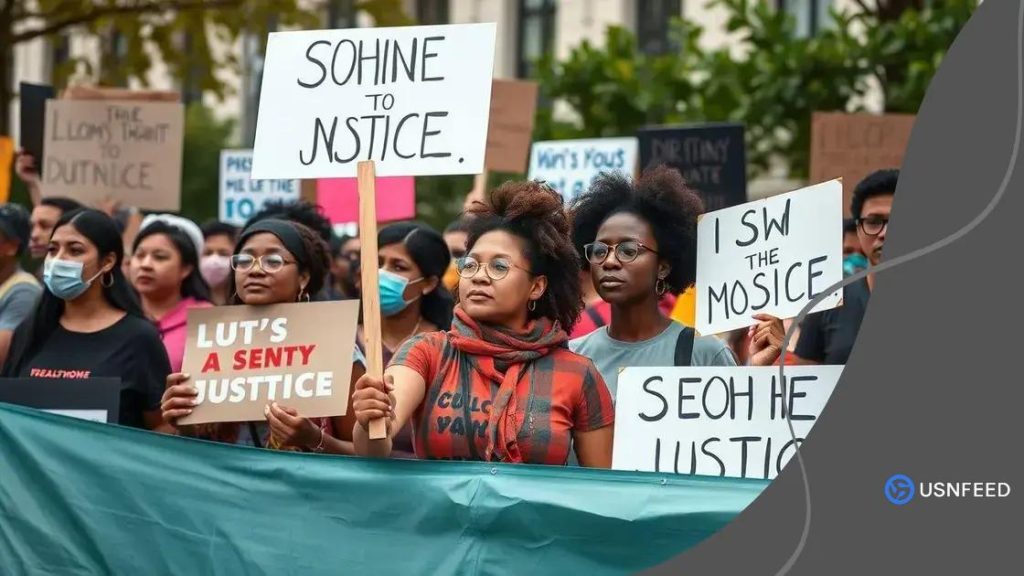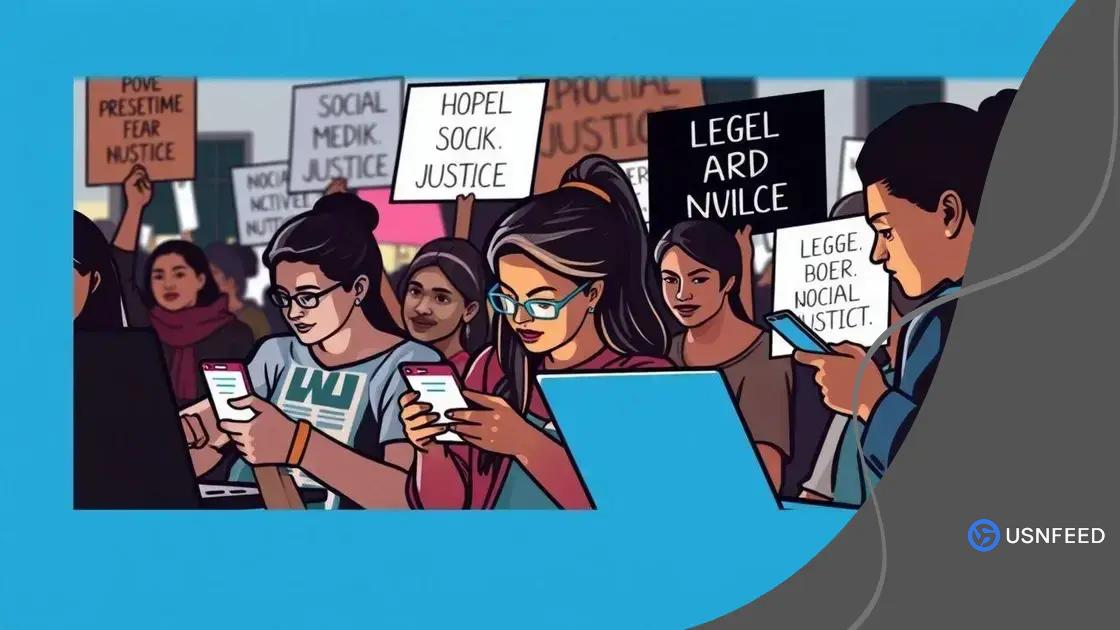Social justice movements USA: understanding their impact

Social justice movements in the USA are vital for advocating equality, addressing issues like systemic racism and gender inequality, while utilizing technology and engaging youth to drive future progress.
Social justice movements USA have played a crucial role in advocating for equity and change. By examining their evolution, we can understand the factors that drive these movements and their lasting effects in society. Have you ever wondered how these movements shape our daily lives?
Key historical events in social justice movements
Key historical events in social justice movements have shaped the path to equality and fairness. Understanding these milestones helps us appreciate how far we’ve come and the ongoing battles we face.
The Civil Rights Movement
The Civil Rights Movement of the 1950s and 1960s was a pivotal time in American history. Activists fought against systemic racism and segregation, striving for equal rights for African Americans. Notable figures, such as Martin Luther King Jr. and Rosa Parks, emerged during this time, inspiring people to join the struggle for justice.
Women’s Suffrage Movement
Another significant event was the Women’s Suffrage Movement. Women fought tirelessly to gain the right to vote. In 1920, the 19th Amendment was passed, granting women the authority to participate in elections. This victory paved the way for further advancements in gender equality.
Stonewall Riots
The Stonewall Riots, which took place in 1969, were crucial for LGBTQ+ rights. These riots were a response to police harassment of patrons at the Stonewall Inn in New York City. The events sparked a movement that continues to advocate for equal rights for the LGBTQ+ community.
Recent Movements
In recent years, movements like Black Lives Matter have gained prominence, addressing police brutality and systemic racism. This movement, sparked by the tragic deaths of African Americans, highlights the ongoing fight against racial injustice. Public protests and social media campaigns have amplified their message, uniting diverse groups.
These key historical events illustrate the power of collective action. They show that when people come together, they can make a significant impact. Each movement reflects a step toward achieving a more just society, emphasizing the importance of continued activism.
Major organizations driving social justice
Major organizations driving social justice play a vital role in advocating for change and equality. These groups work tirelessly to address various issues and to empower communities.
American Civil Liberties Union (ACLU)
The ACLU has been a champion for individual rights since 1920. Their mission is to protect and defend the rights of all Americans. They focus on issues like free speech, voting rights, and racial justice, making significant strides in social justice movements.
NAACP
The National Association for the Advancement of Colored People (NAACP) has a long history in fighting against racial discrimination. Founded in 1909, it seeks to eliminate race-based inequalities and promote social and economic justice for African Americans.
- Legal advocacy and education on civil rights.
- Community outreach programs.
- Advocating for policy changes at local and national levels.
Human Rights Campaign (HRC)
The Human Rights Campaign works primarily for LGBTQ+ rights. They aim to create a world where LGBTQ+ individuals can live openly, without fear. This organization focuses on legal advocacy, public education, and community-building activities.
Their efforts include lobbying for legal protections and enacting policies that support equal rights. Organizations like HRC show how vital activism is to the fight for social justice.
ACLU and NAACP Collaboration
Both the ACLU and NAACP often collaborate on important civil rights cases, creating a robust network of support. Their joint efforts highlight the importance of unity in advancing social justice causes. By joining forces, these organizations can tackle complex issues more effectively, demonstrating the power of collective action.
These major organizations make a significant impact in promoting social change. Their work inspires countless individuals to join the fight for a just society and continues to shape the landscape of social justice movements across the country.
Impact of social media on activism

The impact of social media on activism has been profound and transformative. In recent years, platforms like Twitter, Facebook, and Instagram have become essential tools for advocates.
Raising Awareness
Social media has enabled activists to raise awareness quickly and widely. Campaigns can go viral in just a matter of hours, reaching millions of people all over the world. For instance, online movements can highlight issues like climate change or racial inequality, encouraging further discussion and action.
Building Community
Another significant effect is the ability to create communities. Activists can connect with like-minded individuals through social media groups. This sense of community provides support and amplifies the voices of those fighting for social justice.
- Networking with other activists.
- Sharing resources and information.
- Collaborating on projects and campaigns.
Mobilizing for Action
Social media is critical for mobilization. It serves as a platform for organizing protests, rallies, and events. Activists use these platforms to share logistics and encourage participation. This organizing tool can turn an idea into a significant action swiftly.
However, despite its benefits, social media activism also faces challenges. Miscommunication can spread easily, and misinformation can distort messages. It’s essential for activists to verify information before sharing to maintain credibility. Balancing the fast-paced nature of social media with accurate communication is vital for effective activism.
Conclusion
The rise of social media has reshaped how activism is conducted. Its ability to connect, inform, and mobilize people has changed the landscape. As a result, it is a powerful ally in social movements striving for justice and equality.
Challenges faced by social justice movements
Social justice movements face numerous challenges that hinder their progress. Understanding these obstacles is important for advocates aiming to make a difference.
Systemic Resistance
One major challenge is systemic resistance. Many social justice movements confront established systems that oppose their goals. This resistance can come from governments, corporations, or societal norms that benefit from the status quo. Activists often find it difficult to introduce changes in policies or laws that promote equality and justice.
Misinformation and Public Perception
Misinformation poses another significant hurdle. In today’s digital age, false information can spread rapidly, creating confusion and misrepresenting the goals of social justice movements. This can lead to negative public perception and discourage support from potential allies. Strategies for combating misinformation include promoting media literacy and providing accurate information.
- Encouraging critical thinking about social issues.
- Fact-checking claims before sharing.
- Using credible sources to spread information.
Resource Limitations
Many social justice organizations operate with limited resources. Funding can be challenging to secure, and activists often rely on donations and volunteer work. This lack of resources can impact outreach efforts and the ability to sustain campaigns. Building partnerships with larger organizations may help amplify their voices and access more resources.
Internal Conflicts
Internal conflicts within movements can also arise. Different factions may have varying strategies or priorities, leading to divisions. These conflicts can weaken the movement’s overall effectiveness. It’s crucial for activists to prioritize unity and clear communication to overcome these intra-organizational challenges.
Despite these challenges, social justice movements continue to evolve and adapt. Their resilience in the face of obstacles illustrates the dedication of activists to fight for fundamental rights and justice.
The future of social justice in the USA
The future of social justice in the USA looks both challenging and promising. As society evolves, social justice movements adapt to new issues and methods of advocacy. Understanding what lies ahead can inspire action and participation.
Emerging Issues
As technology advances, new issues emerge that social justice movements must address. Topics like digital privacy, artificial intelligence ethics, and climate justice are gaining attention. Activists are finding ways to connect these issues to traditional social justice causes, ensuring that no group is left behind.
Youth Engagement
Engaging young people is vital for the future of activism. Many young individuals are passionate about social issues, using social media to organize and spread awareness. This generation is more likely to advocate for equality and justice in their communities, making their voices crucial. Schools and universities are also playing a role by creating programs that encourage civic engagement.
- Promoting social justice education in schools.
- Encouraging student activism through clubs and events.
- Providing platforms for youth to share their ideas.
Technology and Advocacy
The role of technology in promoting social justice cannot be overstated. Social media platforms enable rapid information sharing, mobilizing communities for action. Online campaigns can reach global audiences, creating awareness and support for various causes. However, it is essential for activists to use these tools responsibly to combat misinformation and maintain credibility.
Intersectionality
Intersectionality will continue to shape the conversation around social justice. Recognizing how various identities—such as race, gender, and class—intersect is crucial for progress. Advocates must work to ensure that all voices are heard and represented, leading to more effective and inclusive movements.
As movements evolve, strong leadership and resilience are key. The future of social justice in the USA depends on collaboration among various groups and using innovative strategies to create lasting change.
FAQ – Frequently Asked Questions About Social Justice Movements
What are some emerging issues in social justice today?
Emerging issues include digital privacy, climate justice, and the ethics of artificial intelligence, which activists are increasingly addressing.
How can young people get involved in social justice movements?
Young people can engage through school programs, social media activism, and community service, making their voices heard on important issues.
What role does technology play in social justice advocacy?
Technology, especially social media, helps raise awareness, mobilize supporters, and disseminate information quickly to a broader audience.
Why is intersectionality important in social justice?
Intersectionality recognizes that various identities intersect, ensuring that the rights and needs of all marginalized groups are considered in advocacy efforts.